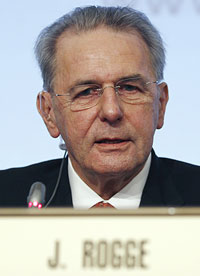The London 2012 Olympics will be the first to have a set of guidelines for female athletes with excessive levels of male hormones, the International Olympic Committee (IOC) decided on Tuesday.
The IOC said this decision was not in response to the high-profile case of South African athlete Caster Semenya, who won the world 800 metres title in 2009 before she was banned by the International Association of Athletics Federations for almost a year pending a gender verification test.
"This has nothing to do with that particular case," the IOC's medical commission chief Arne Ljungqvist said.
 After several years of research the IOC's executive board confirmed on Tuesday the need for the guidelines to be in place by the time of the London Games to determine the eligibility of female athletes with hyperandrogenism.
After several years of research the IOC's executive board confirmed on Tuesday the need for the guidelines to be in place by the time of the London Games to determine the eligibility of female athletes with hyperandrogenism.
This condition describes a female body which produces larger amounts of male hormones.
"There is no way through a simple lab test that we can determine whether a competitor is male or female," Ljungqvist told reporters, rejecting the IOC's past practices including gender screening that was applied until 2000.
He said a group of experts would now work on drafting the guidelines that will be put before the IOC session in Durban, South Africa in July for approval and will come into force for London.
The IOC also agreed to recommend that international federations adopt similar rules.
Ljungqvist said there were several triggers for an investigation to start including if the athlete asks for it.
"But an allegation from a fellow competitor cannot be acceptable for an investigation," he said.
Ljungqvist added that while the guidelines would help provide a level playing field for all female competitors, the condition was exceptionally rare.
"We are structuring rules for elite sport. This is to protect the female sport at Olympic level. In my experience there have only been a handful of cases in the past 10 years."










